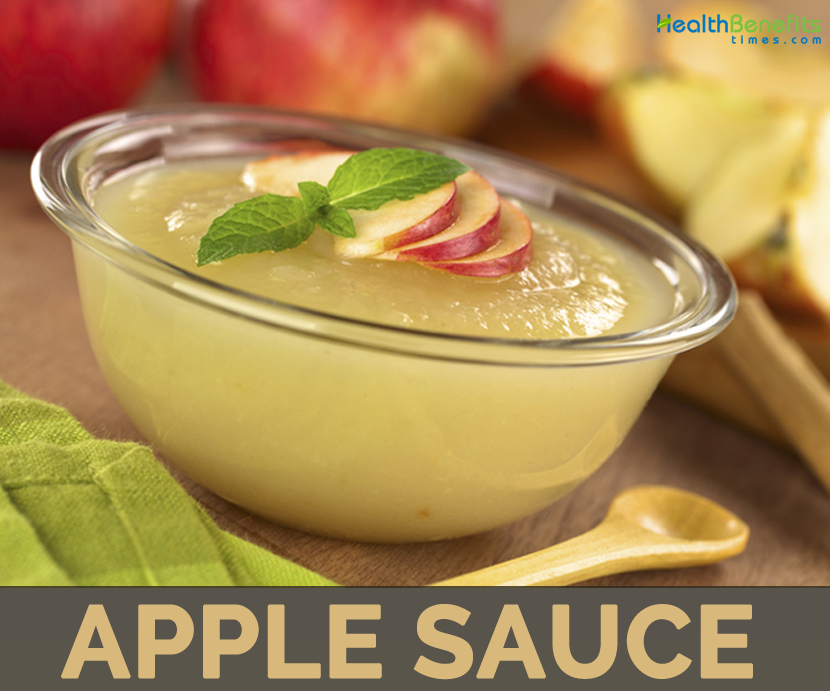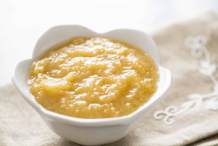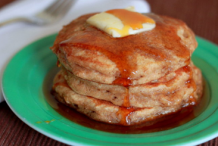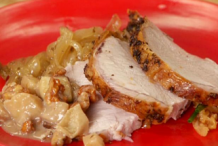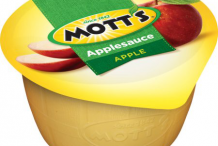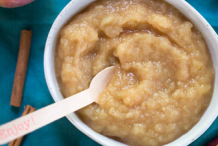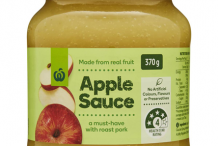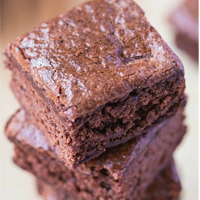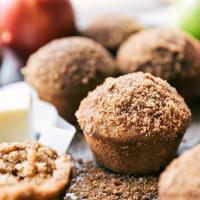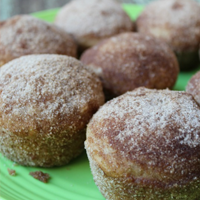Apples, whether whole or as applesauce, consists of fiber and vitamin C. Applesauce naturally contains no fat and few calories per serving if you choose unsweetened varieties or make your own. Enjoy it by itself or substitute it for fats in baked goods to keep them tender. Avoid sweetened applesauce, which is high in added sugar. Although a 1-cup serving of sweetened applesauce provides a slightly higher 3.1 grams of fiber, it also contains about twice as many calories as plain applesauce. This typical dish for children is easy to make and the best part is that it preserves all the benefits and nutrients of the apple. It’s packed with antioxidants, flavonoids, and vitamins. It has capabilities to reduce the risk of cardiovascular disease or cancer (including chronic diseases).
Origins
Applesauce is generally accepted as a European food that originated in the 1700s. It was a convenient way to preserve the life of apples and it paired well with sweet and savory foods.
Health benefits of Apple Sauce
Apples provide high amounts of beneficial phytochemicals, including catechin, chlorogenic acid, phloridzin and quercetin that act as antioxidants to prevent cell damage. These beneficial phytochemicals can lower your risk for asthma, Alzheimer’s disease, cancer, heart disease and Type 2 Diabetes. The beneficial polyphenols in applesauce is close to that in whole apples, and is able to provide many of the same benefits. Listed below are few of the health benefits of apple sauce
1. Improve your digestion
Applesauce consists of a lot of insoluble fiber, but to obtain it you have to leave the peel on in the recipe. It encourages good intestinal transit and healthy bowel movements. For optimum digestive and intestinal function men between the ages of 19 and 50 need 38 grams of fiber a day. Women in the same age range need 25 grams a day. This dish is perfect for people who are suffering from constipation, but to maximize its affects you should also be drinking a lot of water.
2. Satisfy hunger
If you want to lose weight, applesauce can help you there, too. One cup of unsweetened applesauce consists of 100 calories. For a lot of people that’s enough to go a few hours without eating or the temptation to snack on something unhealthy. When you add a tablespoon of shaved almonds or raisins it becomes a dessert that’s packed with healthy fats, protein, and carbohydrates. And you’re feeling of satisfaction will also go up!
3. Restore your appetite
Anyone who is sick and recovering knows that applesauce is a good way to restore the desire to eat. It’s often given to the elderly who can’t chew or swallow food properly. It’s also used with people who have eating disorders like bulimia or anorexia.
Traditional uses and benefits of Apple sauce
- Antioxidants found in apple sauce greatly reduce risks of certain cancers such as lung cancer and liver cancer.
- It is sometimes suggested to combat diarrhea, since it is high in pectin.
- It can also be served as a weaning food for children since it is easy to digest and they don’t need to chew.
Culinary Uses
- It is also a popular accompaniment in the United States and is sometimes served as a dessert there as well, alone or used in making apple sauce cake.
- It is also used alone with toast as a snack.
- In France where it is referred to as compote, it is mostly viewed as a dessert and served at room temperature, with the notable exception of boudin aux pommes (dark blood sausage with apple sauce).
- In Portugal as well, maçã cozida (cooked apple) is solely viewed as a dessert.
- Apple sauce can be used in baking as a substitute for fat (such as butter or oil) or eggs.
- In Sweden and Britain, for instance, apple sauce is usually eaten as a condiment for roast pork.
- In Germany it complements potato pancakes, in the Netherlands, French fries.
- They taste delicious with potato pancakes etc.
- Concentrated apple sauce is called apple butter which is used as a spread on open toasts, sandwiches etc. It can also be used as a filling in pies.
Homemade Applesauce Recipe
Ben Walker, who is a health and fitness specialist at London Fitness, showed us a really simple process of making the sauce online. This is the 9 steps process that he used.
Ingredients
- Apples
- Cinnamon
Instructions
- Soak the apples in vinegar and water in the kitchen sink for a couple of hours to remove any dirt or chemical residue.
- Rinse well after soaking or there will be a slight pickle taste to your applesauce. This step is not as necessary with organic apples, but is still a good way to clean them.
- Quarter and core the washed apples. Leave the skin on because it blends the applesauce later in the process and no pieces of skin are even noticeable, but feel free to peel if preferred.
- Put all the apples in a Crock-Pot, Instant Pot, or similar sized pot on the stove with a little bit of water (less than a cup) and cinnamon to taste.
- Cook the apples on medium heat until soft. Time varies, but expect at least a few hours. The house will smell great all day as they cook!
- When the apples are soft and skins are starting to fall off, turn off the heat and let the apples cool to closer to room temperature so they can be blended safely.
- Use either a blender or hand blender (not hand mixer) to puree the apples until smooth.
- You could also use a hand mill for this. The applesauce is now ready to eat! If storing fresh, pour into clean quart jars, top with lid, and store in refrigerator.
- For hot water bath canning: Reheat the now smooth applesauce to boiling and then turn off heat. Immediately put into very clean jars and can according to your canner instructions.
Recipes
Flourless Greek Yogurt Zucchini Brownies
Ingredients
- 1 ¼ cups gluten free oat flour (can sub for gluten free, whole meal or white but it won’t be flourless)
- 1 tsp baking powder
- pinch sea salt
- 3 T dark cocoa powder
- 1/2 scoop vegan protein powder of choice (optional)
- 3/4 cup coconut palm sugar (Can sub for any granulated sweetener of choice)
- 1/4 cup dairy free chocolate chunks
- 3/4 cup applesauce (can sub for canned pumpkin, mashed banana)
- 1/4 cup grated zucchini, excess liquid removed
- 3/4 cup dairy free Greek yogurt
- 2 flax eggs (can sub for 2 whole eggs)
Instructions
- Preheat the oven to 180 degrees Celsius. Grease a large, deep baking tray or 9 x 9 brownie pan with oil or butter and set aside.
- In a large mixing bowl, combine the gluten free oat flour, baking powder, salt, cocoa, protein powder is using it and sugar or sweetener of choice and mix until combined. Stir through the chocolate chunks.
- In a separate bowl, combine the applesauce, zucchini, Greek yogurt and flax eggs or whole eggs and mix well. Add the wet mixture to the dry mixture and stir until fully incorporated.
- Pour the batter into the greased pan and bake for 45- 50 minutes, or until a toothpick comes out clean. Allow to cool completely before slicing into pieces.
Healthy Applesauce Muffins
Ingredients
- 1 and 1/2 cups white flour or white whole wheat flour
- 1 tablespoon cornstarch
- 1/2 teaspoon baking soda
- 1/4 teaspoon salt
- 1/2 teaspoon apple pie spice
- 1 teaspoon ground cinnamon
- 3/4 cup applesauce sweetened or unsweetened
- 1 large egg
- 1/2 cup vanilla Greek yogurt
- 1/4 cup melted coconut oil
- 1 teaspoon vanilla extract
- 1/2 cup brown sugar lightly packed
Sugared Topping
- 1/2 teaspoon apple pie spice or cinnamon
- 4 tablespoons brown sugar not packed
- 3-4 tablespoons melted coconut oil
Instructions
- Preheat the oven to 350 degrees F. Spray 12 cavities of a muffin tin and lightly flour. Do not use muffin liners as these muffins will stick to them. Set aside.
- In a large bowl, add in the flour. Add in the cornstarch, baking soda, salt, apple pie spice, and cinnamon. Mix until combined.
- In another bowl, mix together the applesauce, large egg, Greek yogurt, coconut oil (measured when melted and then cooled to room temperature before added to the bowl), vanilla extract, brown sugar. Mix until well combined.
- Mix the wet and dry ingredients until JUST combined. Over-mixing yields denser muffins.
- Fill up 11 to 12 muffin cavities evenly with the mixture — each cavity will be a little over 3/4ths the way full. You should use all the batter on 11 or 12 cavities so fill them pretty full.
- (Fill any empty cavities of the muffin tin with water to ensure even baking.)
- Bake for 17-23 minutes or until a fork when inserted in the center comes out clean.
- Remove and allow to cool for a few minutes before removing the muffins from the tin. Use a spoon to coax the muffins out after about 5 minutes.
- In a small bowl, toss together the apple pie spice OR cinnamon and brown sugar.
- In another small bowl add the melted coconut oil.
- Dip the warm muffins in the melted coconut oil and then dip them in the sugar mixture. Spoon extra sugar mixture on top and press it into the muffin.
- Repeat for all the muffins.
- Store leftover muffins in an airtight container in the fridge. Let come to room temperature before eating.
- Muffins best enjoyed within 3 days.
Applesauce Puffs
Ingredients
- 2 c biscuit mix
- 1/4 c sugar
- 2 tsp cinnamon
- 1/2 c applesauce (I used natural)
- 1/4 c milk
- 1 egg
- 2 T oil
Cinnamon Sugar Mixture
- 1 1/2 tsp cinnamon
- 1 cup sugar
- 1/4 cup melted butter
Instructions
- Mix biscuit mix, sugar and cinnamon
- Mix in applesauce, milk, egg and oil
- Stir well
- Fill greased muffin pans 2/3 full
- Bake @375 for 15 minutes
- Remove immediately from pan and roll in melted butter
- Combine cinnamon and sugar in a small bowl and roll muffin with melted butter on it in mixture
- Let cool and serve
Cinnamon Applesauce Pancakes
Ingredients
- 2 cups of sifted flour
- 4 teaspoons of baking powder
- 2 cups of water
- 2 tablespoons of sugar
- ½ teaspoon of iodized salt
- ½ cup of cinnamon applesauce
- ¼ teaspoon of vanilla extract
Instructions
- Mix together all the dry ingredients thoroughly.
- Add remaining ingredients and beat until smooth.
- Pour a half cup batter on hot Teflon pan, or lightly oiled skillet.
- Turn the pancake when surface become bubbly. Cooking time per pancake is 3 to 5 minutes, depending on its thickness.
Comments
| Apple sauce Quick Facts | |
|---|---|
| Name: | Apple sauce |
| Origin | Europe |
| Colors | Dull yellow color that can have a slight green or red tinge |
| Shapes | Very fine and smooth to slightly coarse grained |
| Taste | Sweet or slightly sour according to apple |
| Calories | 167 Kcal./cup |
| Major nutrients | Carbohydrate (33.10%) Copper (8.78%) Total dietary Fiber (7.89%) Vitamin B6 (5.08%) Vitamin C (4.67%) |
| Health benefits | Improve your digestion, Satisfy hunger, Restore your appetite |
| Name | Apple sauce |
|---|---|
| Native | Europe |
| Common Names | Apple compôte’ |
| Texture | Very fine and smooth to slightly coarse grained |
| Color | Dull yellow color that can have a slight green or red tinge |
| Taste | Sweet or slightly sour according to apple |
| Typical ingredients | Water, cinnamon, honey or sugar |
| Commonly served with | Meat dishes, notably pork, as well as vegetables, and sometimes it complements sweet dishes, like pancakes |
| Packaged in | Glass jars, tins, or plastic tubs |
| Cooking Time | Less than an hour to a couple hours |
| Major Nutritions | Carbohydrate 43.03 g (33.10%) Copper, Cu 0.079 mg (8.78%) Total dietary Fiber 3 g (7.89%) Vitamin B6 (Pyridoxine) 0.066 mg (5.08%) Vitamin C (Ascorbic acid) 4.2 mg (4.67%) Vitamin B2 (Riboflavin) 0.054 mg (4.15%) Potassium, K 184 mg (3.91%) Iron, Fe 0.3 mg (3.75%) Vitamin B1 (Thiamin) 0.042 mg (3.50%) Manganese, Mn 0.074 mg (3.22%) |
| Calories in 1cup (246 gm) | 167 Kcal |
| Health Benefits |
|


